NCERT Solutions for Class 5 Maths - Parts and Wholes
NCERT Textbook Page 50
Our Flag
Q.1: Draw a rectangle of length 9 cm and width 6 cm. Divide it into three equal parts and complete the flag.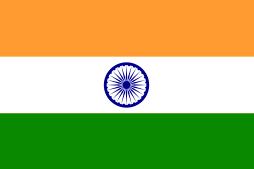 The Flag of IndiaThe top one-third of our flag is saffron (or orange).
The Flag of IndiaThe top one-third of our flag is saffron (or orange).
(i) What is the colour of the middle one-third of the flag?
Sol: The colour of the middle one-third of the flag is white.
(ii) Where will you draw the Ashoka Chakra?
Sol: I will draw the Ashoka Chakra in the middle of the white portion of the flag.
(iii) How much of the flag will you colour green?
Sol: (1/3)rd portion of the flag will be coloured green.
(iv) Is the white colour now less than 1/3 of the flag? Why?
Sol: Yes, the white colour is less than 1/3 of the flag because the Ashoka Chakra is present in the white portion.
The Flag of Afghanistan
Q2: Now look at this flag. How much of it is black? The Flag of Afghanistan
The Flag of Afghanistan
Sol: There are 3 portions, so the 1/3rd portion of the flag contains black colour.
(i) The green part of the flag can be written as.
Sol: The green part of the flag can be written as one-third.
(ii) Is red less than one-third of the flag? Why?
Sol: Yes, the red colour is less than 1/3 of the flag because the white emblem is present in the red portion.
The Flag of Myanmar
Q3: This is the flag of Myanmar, our neighbour.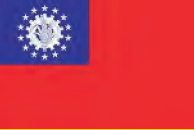 The Flag of Myanmar
The Flag of Myanmar
(i) Is blue more than one-fourth of the flag or less?
Sol: The blue colour is less than one-fourth of the flag.
(ii) Guess how much of the flag is red. Is it more than ½? Is it more than three-fourths?
Sol: It is more than half and also, it is more than three-fourths.
NCERT Textbook Page 51
Find Out
1. Collect as many flags as you can. How many flags have three colours? Are all the coloured parts equal in these flags?Ans:
- USA
- Malaysia
- Azerbaizan
- United kingdom
- Venuzuela
- Ghana
 Examples
Examples
2. This is the flag of the Math Club in a school in Kerala. What part of the flag is coloured red? What part is green?
Ans: 
- The two-fifth part of the flag is in red color.
- One-fifth part of the flag is in green color.
2. Is there a Math Club in your school? If not, ask your teacher how to set it up. Design a flag for your Math Club. Draw it here.
Ans. No, there is no Math Club in my school. I have requested my teacher to help us in setting up a Math Club. I have designed the following flag for our math club.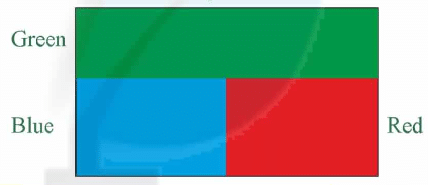
3. Have you used the red colour? What part of the flag did you colour red? What were the other colours you choose?
Ans. Yes, I have used the red colour. Less than half of the flag is coloured red. Other colours used are green and blue.
NCERT Textbook Page 52
Magic Top
Let us make a magic top.- Take a cardboard piece.
- Draw a circle of radius 3 cm and cut it out.
- Divide the circle into 8 equal parts. Now each part is 1/8 of the circle.
- Colour 2/8 red, 1/8 orange, 1/8 yellow, etc. as shown here.
- Push a matchstick through the centre of the circle.Your magic top is ready Spin it fast!
Q.1. What do you see? Can you see all the colours? Write, what you see in your notebook.
Ans. When the magic top is spinning, we cannot see the colours properly. We see a white circular top spinning.
Practice Time
(A) Chocolate Bar
Chocolate bar Manju had a chocolate. She gave one-fourth of it to Raji, one-third to Sugatha and one-sixth to Sheela. She ate the remaining part. How many pieces of chocolate did each get? Write here.
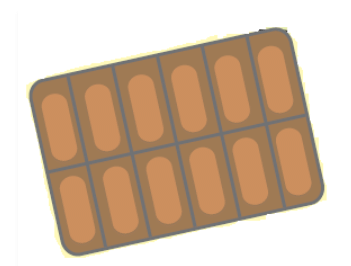 Ans:
Ans:
Manju had a chocolate.
Number of bites in the chocolate is 12.
She gave one-fourth of it to Raji = ¼ × 12 = 3 bites
Sugatha got one-third of it = (1/3) × 12
= 4 bites
Sheela got one-sixth of it = (1/6) × 12
= 2 bites
What part of the chocolate did Manju eat?
Part of the chocolate remains with Manju = 12 – (3 + 4 + 2)
= 12 – 9
= 3 bites
Therefore, Manju ate 3 bites of chocolate.
NCERT Textbook Page 53
(B) Colour the Hats
Colour the hats colour of the hats red. Colour three-fifth hats blue. How many hats did you colour red? How many hats did you colour blue? What part of the hats are not coloured?
Sol:
The total number of hats in the given figure = 15
Out of 15 colours, 1/3 of the hats are in red = 1/3 × 15= 5 hats
Out of 15 colours, three-fifth of hats are in blue = 3/5 × 15= 3 × 3= 9 hats
5 hats are coloured red.
9 hats are coloured blue.
Number of hats coloured = 14Total number of hats = 15
So, the number of hats not coloured = 15 – 14= 1 hat
Therefore, (1/15)th part of the hats are not coloured.
(C) Equal Parts of a Triangle
(i) The white triangle is divided into three equal parts. Fill each one-third part with a different colour.
Can you show that these parts are equal? Think how?
Sol: (i) Since, one triangle is divided into three equal parts, therefore, each part is one-third 1/3 of the whole triangle.
Let us 1/3 in each part and colour them in different colours as shown in the above figure.
In order to show that these parts are equal.
Let us name them, as T1, T2 and T3.
Trace any of them, say T1.
Now place traced part over T2 and T3.
We find that T1 covers T1, T2 and T3 are of the same shape and size.
Hence, these triangles are equal.
(ii) Now try to make three parts of the triangle in a different way. Colour each one-third with a different colour.
Sol: (ii) The given triangle is divided into three equal parts of showing the adjoining figure. Each one-third part is coloured differently.
NCERT Textbook Page 54
(D) Six Parts of a Rectangle
Discuss
(i) How will you check that each part is really one-sixth of that rectangle?
Sol: Trace a rectangle equal to any one of the six parts of one of the figures.
Put the trace out rectangle on the remaining parts one by one.
It overlaps completely.
This showed that each all part is one sixth of the given rectangle.
In the same, we can find out in case of the other figure.
(ii) The green rectangle is bigger than the blue one.
Can we say that 1/6 of the green rectangle is bigger than 1/6 of the blue rectangle.
Sol: Yes, we can say that 1/6 of the green rectangle is bigger than 1/6 of the blue rectangle.
NCERT Textbook Page 57
Patterns in Parts
Q1: Make different patterns by colouring some squares in the grids A, B, C, D. What part of the grid did you colour? What part of the grid remained white? Write.
(A)
Sol: 4/16 blue, 12/16 white.
(B)
Sol: 4/16 is black, 12/16 white.
(C)
Sol: 8/16 black, 8/16 white
(D)
Sol: 7/16 black, 9/16 white.
Q2: Look at grid A again. Is the grid coloured:
Mark (X) on the wrong answer.
Sol: (c) is the wrong answer.
Q3: Draw grids of 16 squares and make patterns with
(a) 2/8 red, ½ yellow, ¼ green
(b) 3/16 blue, 5/16 red, ½ gree
Sol:
(a) 2/8 red, ½ yellow, ¼ green
Out of 16 squares 2/8 red = 2/8 × 16= 2 × 2= 4 red squares
Out of 16 squares ½ yellow = ½ × 16= 1 × 8= 8 yellow squares
Out of 16 squares ¼ green = ¼ × 16= 1 × 4= 4 green squares
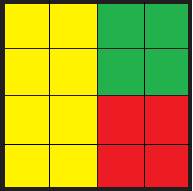
(b) 3/16 blue, 5/16 red, ½ green
Out of 16 squares 3/16 blue = 3/16 × 16= 3 × 1= 3 blue squares
Out of 16 squares 5/16 red = 5/16 × 16= 5 × 1= 5 red squares
Out of 16 squares ½ green = ½ × 16= 1 × 8= 8 green squares
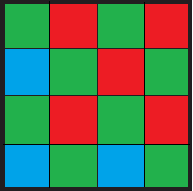
NCERT Textbook Page 58
Ramu’s Vegetable Field
Q1: Ramu’s vegetable field has 9 equal parts. What vegetables does he grow?
(i) Which vegetable grows in the biggest part of the field? What part?
(ii) On what part of the field does he grow potatoes?
(iii) What parts of the field is used to grow spinach? What part is used for brinjals?
Sol:
Ramu grows chillies, potatoes, brinjals, tomatoes and spinach.
(i) Tomatoes grow in the biggest part of his field. It grows in one-third part of the field.
(ii) He grows potatoes on 2/9 part of the field.
(iii) 1/9 part of field is used to grow spinach. 2/9 art of the field is used for brinjals.
Q2: Ramu wanted to give these vegetables to his friends. He gave Aboobacker one-fifth of these tomatoes and 1/3 of the potatoes. Srija got 2/5 of the tomatoes and 3/6 of the potatoes. Nancy got the rest of these vegetables. Circle Aboobacker’s share in blue. Circle Srija’s share in yellow.
How many potatoes and tomatoes did Nancy get?
Sol:

From the given figure, total number of potatoes = 18
Total number of tomatoes = 20
From the question, Ramu wanted to give these vegetables to his friends.
Aboobacker got one-fifth of these tomatoes = (1/5) × 20= 1 × 4= 4
Aboobacker got 1/3 of the potatoes = (1/3) × 18= 1 × 6= 6
Srija got 2/5 of the tomatoes = (2/5) × 20= 2 × 4= 8
Srija got 3/6 of the potatoes = (3/6) × 18= 3 × 3= 9
Then, Nancy got the rest of these vegetables.
Total number of vegetables, including potatoes and tomatoes = 20 + 18= 38
Number of vegetables Aboobacker and Srija got = 4 + 6 + 8 + 9= 27
So, Nancy got = 38 – 27= 11 vegetables

How many potatoes and tomatoes did Nancy get?
Sol:
From the above solution,
Total number of tomatoes = 20
Total number of potatoes = 18
Then, number of tomatoes Aboobacker and Srija got = 4 + 8= 12
Number of potatoes Aboobacker and Srija got = 6 + 9= 15
Now, number of tomatoes Nancy got = 20 – 12= 8 tomatoes
Number of potatoes Nancy got = 18 – 15= 3
NCERT Textbook Page 60
Game: Who colours the Circle Fast?
Q1: This game is to be played in groups of 4. Each player has to make a circle as shown. Each one has to make 15 tokens on slips on paper.
Write
Shuffle, the tokens and make a pile in the middle of the group. Now you are ready to start the game. The first player takes a token from the pile, colours that part of the picture, and puts the token under the pile. The next player does the same, and so on. The winner is the one who first colours the circle completely.
(i) Who won the game?
(ii) What are the winner’s tokens?
(iii) Write the tokens you got.
(iv) What part of the circle did you colour?
Sol: Each of the 4 players should make a circle as shown.
Each one of them should make 15 tokens on slips of paper and write to make the above and tokens.
Let us play the game as directed.
(i) I won the game.
(ii) The winner’s tokens are 1/2 and 6/12 .
(iii) I got tokens bearing numbers 1/2 and 6/12.
(iv) I coloured the circle completely.
NCERT Textbook Page 61
Guess and Check
(A) What part of each shape is coloured?
First, guess the answer, then check.
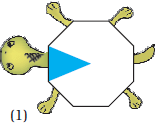
Sol:
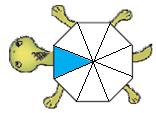
By looking at the figure, we can say that 1/8 of the shape is coloured.
(2)
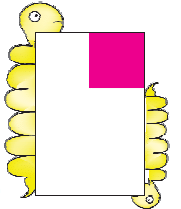
Sol:
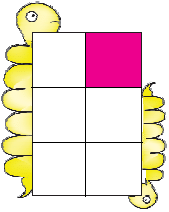
By looking at the figure, we can say that 1/6 of the shape is coloured.
(3)
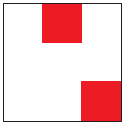
Sol:
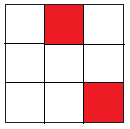
By looking at the figure, we can say that 2/9 of the shape is coloured.
(4)
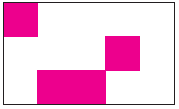
Sol:
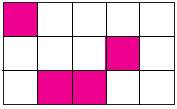
By looking at the figure, we can say that 3/12 of the shape is coloured.
NCERT Textbook Page 62
Coloured Parts
Q1: Complete these
(i)

This circle is divided into two equal parts. Out of equal parts, one part is coloured blue.
Sol: This circle is divided into two equal parts. Out of equal 2 parts, one part is coloured blue.
(ii)
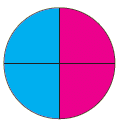
Here, the circle is divided into equal parts. Out of equal parts, parts are coloured blue.
Sol: Here, the circle is divided into four equal parts. Out of four equal parts, two parts are coloured blue.
(iii)

Here, the circle is…………………………………………………………
Sol: Here, the circle is divided into six equal parts. Out of six equal parts, three parts are coloured blue.
(iv)
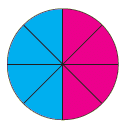
Here, the circle is…………………………………………………………
Sol: Here, the circle is divided into eight equal parts. Out of eight equal parts, four parts are coloured blue.
So, we can say that ½ = (2/4) = (3/6) = (4/8)
NCERT Textbook Page 63
Cutting the halwa
Q1: Ramesh bought a piece of halwa for his children Ammu and Anu. He divided it equally for them.
(a) Each will get ______ part of halwa.
Sol: Each will get 1/2 part of halwa.
This piece is too big. We can’t eat it. They said. So, he divided the piece into half again. Now, many pieces will Ammu get?
2 pieces.
(b) What part of the halwa is it? 2/4
Sol:Make it even smaller. Dad asked. So, he again cut the halwa into smaller pieces. Ok, thank you, Dad.
(c) Now how many pieces will each get?
Sol: Now each of them will get 4 pieces.
(d)What part of the halwa is each piece now?
Sol: Each piece now is 1/8 of the halwa.
(e) If Ramesh had cut the halwa into 6 equal parts how many pieces would each have got? Look at your answers for questions 1 to 4 and write:
 = ……=…..=…..=……=…..
= ……=…..=…..=……=…..
Sol: If Ramesh had cut the halwa into 6 equal parts, then each would get 3 pieces.
NCERT Textbook Page 64
Q1: Parts of the Strip
(i) Look at the picture. Write what part of the strip is each green piece. Write the part for a piece of each colour.
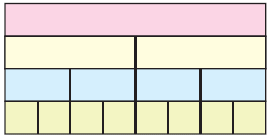
Sol:

(ii) How many one-fourths will make a half?
Sol:
Two one-fourth will make a half.
= ¼ + ¼
= 2/4 [divide both numerator and denominator by 2]
= ½ = half
(iii) How many 1/8 will make ¼?
Sol:
Two 1/8 will make ¼.
= 1/8 + 1/8
= 2/8 [divide both numerator and denominator by 2]
= ¼
(iv) How many 1/8 are in ½?
Sol:
Four 1/8 are in ½.
= 1/8 + 1/8 + 1/8 + 1/8
= 4/8
= ½ [divide both numerator and denominator by 4]
Q2: Patterns
Look at the square.
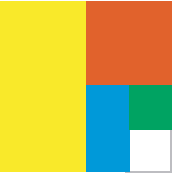
(i) What part is coloured blue?
Sol:

From the above figure, we can say that out of 16 squares, 2 squares are coloured blue.
i.e. 2/16 or 1/8 part is coloured blue.
(ii) What part is green?
Sol:
From the above figure, we can say that, out of 16 squares, 1 square is coloured green.
i.e., 1/16 part is coloured green.
Q3: From a Part to the Whole
(i) This show 1/5 petals of a flower. Complete the flower by drawing the other petals.

Sol:

(ii) The picture shows one-third of the blades of a fan. Complete the picture by drawing the other blades.
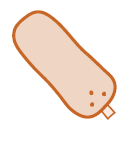
Sol:
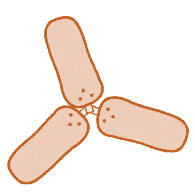
(iii) Half of the blades of another fan are shown here. Complete the picture by drawing the other half. How many blades have you drawn?

Sol:

NCERT Textbook Page 65
Q1: Rupees and Paise
(a) How many will make one rupee?
Sol: Two 50-paise will make one rupee.
(b) Is 50 paise half of one rupee?
Sol: Yes, 50 paise is half of one rupee.
(c)How many will make one rupee?
Sol: Four 25-paise will make one rupee.
25 paise is 1/4 part of one rupee.
20 paise is 1/5 part of one rupee.
(d) How many 10-paise will make one rupee?
Sol: Ten 10-paise will make one rupee.
NCERT Textbook Page 67
Q.1.: Arun’s TimeTable
Sleeping: One third of a day
Use different colours to show
Playing: One eighth of a day
Studying: ¼ of a day
Sol:
We know that, 24 hours in a day and above figure contains 25 box.
So, Arun spent one eighth of a day for playing = (1/8) × 24
= 1 × 3
= 3 hours = 3 box
He spent ¼ of a day for studying = ¼ × 24
= 1 × 6
= 6 hours = 6 box

Sleeping Playing Studying Other activities
(i) How many hours does Arun take for Sleeping, studying and Playing?
Sol: 8 hours for sleeping, 6 hours for studying and 3 hours for playing.
(ii) What part of the day does he use for other activities?
Sol: He uses the 7/24 part of the day for other activities.
NCERT Textbook Page 68
School Magazine
Q1: A School has decided to bring out a magazine every quarter of the year. How many magazines will they have in a year? If they want to print it at the end of each quarter of a year, which are the months for printing? Mark the number for those months.
Sol: Every quarter of the year means every 1/4 of the year. It is exhibited on the strip as under:
They will have four magazines in a year.
In order to print the magazine at the end of each quarter of the year, they should print it in the months of March, June, September and December. These months are encircled on the strip.
Q2: Sleeping Beauty!
Have you heard of Kumbhakarna, the brother of Ravana? He is famous for sleeping for half a year.
(a) Most people sleep about 8 hours a day. Then what part of a day is it?
(b) So what part of a year do they sleep? A person 60 years old must have slept ….years.
Sol: Yes, I have heard of Kumbhakarna, the brother of Ravana.
(a) We know that, 24 hours a day.
Given, most people sleep about 8 hours a day = 8/24
= 1/3 part of a day
(b) A person 60 years old must have slept for = 1/3 × 60
= 1 × 20
= 20 years
NCERT Textbook Page 69
Keerti’s Shopping List
Q1: Look at the yellow price list.
 (a) How much does 2 kg of tomato cost?
(a) How much does 2 kg of tomato cost?
(b) How much does 1/2 kg of tomato cost?
(c) Kiran wants kg of tomato. How much will it cost?
(d) How much does kg of potato cost?
(e) What is the price of kg of carrot?
(f) He bought a gourd of weight kg and it costs……
(g) Look at the shopping list in Keerti’s hand. How much will she have to pay to buy all the these?
(h)Make a bill of your own for vegetables you want to buy. Find the total money you will have to pay.
Sol:
(a) 2 kg of tomato costs = Rs. 12 2 = Rs. 24
2 = Rs. 24
(b) kg of tomato costs = Rs. 12

=Rs. 6
(c) Cost of kg of tomato
= Cost of 2 kg of tomatoes +Cost of kg of tomato
= Rs. 12 2+Rs. 12
2+Rs. 12
=Rs. 24 +Rs.6 = Rs. 30
(d) Cost of  kg of potato
kg of potato
= Cost of 3 kg of potato + Cost of kg of potato
= 10 3+Rs. 10
3+Rs. 10
=Rs. 30+ Rs. 5= Rs. 35
(e) Cost of  kg of carrot
kg of carrot
= Cost of 1 kg of carrot + Cost of  kg of carrot
kg of carrot
= Rs. 18+ Rs. 18
 = Rs. 18 + Rs. 4.50= Rs. 22.50
= Rs. 18 + Rs. 4.50= Rs. 22.50
(f) Cost of kg of gourd
= Cost of 4 kg of gourd + Cost of of gourd kg
= Rs. 8  4 + Rs. 8
4 + Rs. 8 
= Rs. 32 + Rs. 6 = Rs. 38
(g) Keerti’s shopping
(h) Own Shopping ( Sample Answer)
NCERT Textbook Page 70
Q.1. Raheem’s Journey
Raheem has to travel km to reach school. What distance does he travel to go to school and come back home?
Sol: The distance travelled by Raheem to go to school and come back
= km
 2=5/4 km
2=5/4 km  2=5/2 km =
2=5/2 km = km
Q.2. What coins?
Lata bought a pencil and a pen for seven and a half rupees. She gave Rs. 10. The shopkeeper gave back the money in half and quarter rupees. What are the coin she got?
Sol:
From the question, it is given that
Latha bought a pencil and a pen for = ₹ 7½
Money given by Latha to the shopkeeper = ₹ 10
Shopkeeper gave back the money = 10 – 7.5 = ₹ 2.5
So, the shopkeeper can return ₹ 2.5 in the following ways:
- 1 half rupee coin and 8 quarter rupee coins
- 2 half rupee coins and 6 quarter rupee coins
- 3 half rupee coins and 4 quarter rupee coins
- 4 half rupee coins and 2 quarter rupee coins
Q.3. At the railway station
Your attention, please. Mangalore Express coming from Mangalore and going to Thiruvananthapuram, is now running late by half an hour.
Oh, the train is late today. The right time is a quarter to 7.
(a) What time is the train expected to come today?
Solution:-
- The right time is a quarter to 7, i.e., 6: 45
- But, the train is delayed by half an hour, i.e., 30 minutes.
- So, the exact time the train will arrive at 6: 45 + 0: 30 = 7: 15
(b) Nazia gets off at a station after hours from this station. What time will she get off?
Sol:
- From the question,
- Nazia gets off at a station after = 2: 30 hours
- Then, total time taken by Nazia to reach = 2: 30 + 7: 15 = 9: 45
(c) Shaji will take 5 hours to reach Ernakulam by this train. At what time will he reach there?
Sol:
- From the question, it is given that
- Shaji will take 5 hours to reach Ernakulam.
- Then, the total time taken by Shaji to reach Ernakulam = 7: 15 + 5 = 12: 15
|
31 videos|192 docs|41 tests
|
FAQs on NCERT Solutions for Class 5 Maths - Parts and Wholes
| 1. What are parts and wholes in mathematics? |  |
| 2. How do you represent parts and wholes visually? |  |
| 3. Why is it important to understand parts and wholes in everyday life? |  |
| 4. How can we find the fraction of a whole? |  |
| 5. What activities can help students learn about parts and wholes? |  |






















